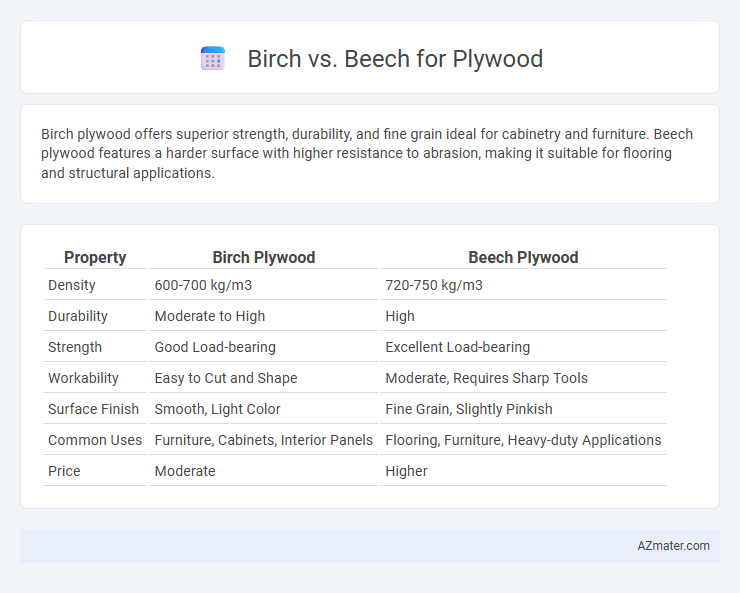Birch plywood offers superior strength, durability, and fine grain ideal for cabinetry and furniture. Beech plywood features a harder surface with higher resistance to abrasion, making it suitable for flooring and structural applications.
Table of Comparison
| Property | Birch Plywood | Beech Plywood |
|---|---|---|
| Density | 600-700 kg/m3 | 720-750 kg/m3 |
| Durability | Moderate to High | High |
| Strength | Good Load-bearing | Excellent Load-bearing |
| Workability | Easy to Cut and Shape | Moderate, Requires Sharp Tools |
| Surface Finish | Smooth, Light Color | Fine Grain, Slightly Pinkish |
| Common Uses | Furniture, Cabinets, Interior Panels | Flooring, Furniture, Heavy-duty Applications |
| Price | Moderate | Higher |
Introduction to Birch and Beech Plywood
Birch plywood is known for its strength, durability, and smooth surface, making it ideal for furniture and cabinetry requiring a fine finish. Beech plywood offers a tight grain pattern and excellent resistance to wear, commonly used in flooring and construction applications where stability is crucial. Both materials provide reliable structural integrity, but birch excels in aesthetic appeal while beech emphasizes robustness.
Botanical Differences Between Birch and Beech
Birch plywood is derived from deciduous hardwood trees in the genus Betula, characterized by a pale, smooth bark and fine grain pattern. Beech plywood comes from Fagus species, known for their dense, hard wood with a tight, uniform grain and a reddish hue. The botanical differences influence the plywood's texture and durability, with birch offering a softer feel and beech providing superior hardness and resistance to wear.
Grain Patterns and Appearance Comparison
Birch plywood features a fine, even grain with a pale, creamy color, making it ideal for a smooth, consistent finish and modern aesthetics. Beech plywood presents a tight, straight grain with a warm, reddish-brown hue that adds rich, natural warmth and distinctive character to furniture and cabinetry. The subtle contrast between birch's light uniformity and beech's warmer, more pronounced grain patterns influences the overall visual appeal and application suitability in woodworking projects.
Strength and Durability: Birch vs Beech
Birch plywood is known for its excellent strength-to-weight ratio, making it highly durable and resistant to wear, which is ideal for heavy-duty applications. Beech plywood offers superior hardness and impact resistance, providing enhanced durability for furniture and flooring. Both woods provide reliable strength, but birch typically outperforms beech in structural uses due to its more consistent grain and higher tensile strength.
Workability and Ease of Machining
Birch plywood offers superior workability due to its consistent grain and smooth surface, making it easier to cut, sand, and finish with minimal splintering. Beech plywood, while durable, tends to have a tighter grain that can cause increased tool wear and requires sharper blades for clean machining. Both types are suitable for precise woodworking, but birch is often preferred for detailed projects requiring fine cuts and smooth edges.
Resistance to Moisture and Warping
Birch plywood exhibits superior resistance to moisture and warping compared to beech plywood due to its tighter grain structure and higher natural durability. Beech plywood, while strong, tends to absorb more moisture, making it more susceptible to swelling and deformation in damp environments. For applications requiring enhanced stability and longevity in humid conditions, birch plywood is the preferred choice.
Cost and Availability of Birch and Beech Plywood
Birch plywood is generally more affordable and widely available than beech plywood, making it a popular choice for woodworking and furniture projects. Birch plywood offers consistent strength and smooth surface quality, whereas beech plywood tends to be pricier due to limited availability and denser grain. The cost-effectiveness and accessibility of birch plywood contribute to its dominance in commercial and DIY markets over beech plywood.
Environmental Impact and Sustainability
Birch plywood is known for its durability and smooth finish, but it often requires more energy-intensive processing and frequent use of adhesives that may impact indoor air quality. Beech plywood, sourced from fast-growing beech trees, tends to have a lower environmental footprint due to more sustainable harvesting practices and higher natural resistance to pests, reducing the need for chemical treatments. Both options benefit from certifications like FSC and PEFC, which ensure sustainable forest management and promote responsible sourcing in plywood production.
Popular Applications and Uses
Birch plywood is widely favored for furniture making, cabinetry, and interior paneling due to its fine grain, strength, and smooth finish that accepts paint and stain well. Beech plywood, known for its excellent bending properties and hardness, is commonly used in steam-bent furniture, flooring, and tool handles where durability and flexibility are essential. Both types are popular in woodworking and construction, but birch is preferred for aesthetic applications, while beech excels in functional, high-wear environments.
Choosing the Right Wood: Birch or Beech for Your Project
Birch plywood offers a smooth grain and high strength, making it ideal for cabinetry and furniture that require both durability and aesthetic appeal, while beech plywood is known for its hardness and resistance to wear, perfect for heavy-use surfaces like flooring and workbenches. Birch's light color and fine texture provide excellent paint adhesion and a clean finish, whereas beech's tighter grain and reddish hue give a warm, natural look suitable for visible structural components. Selecting between birch and beech depends on the specific needs of your project, balancing factors like appearance, strength, durability, and workability.

Infographic: Birch vs Beech for Plywood
 azmater.com
azmater.com